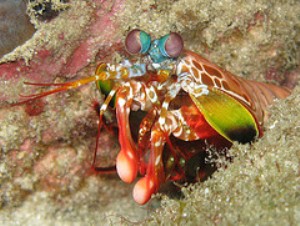A Charles Godfrey Binder professor of engineering science and mechanics at Penn State, Akhlesh Lakhtakia, collaborated with engineers from the National Taipei University of Technology to formulate a technique for manufacturing materials that are periodically multilayered similar to the lens in the peacock mantis shrimp’s eye.
These materials can be used as waveplates in the visible light spectrum and cannot delaminate as they are built as one complete piece. The researchers have published their work in Nature Communications.
 Peacock Mantis Shrimp
Peacock Mantis Shrimp
The research team manufactured the waveplate using two nanorod layers that exhibit the same arrangement as seen in the peacock mantis shrimp’s eye. Researchers used various deposition processes to produce a multilayered thin film. To start with they used tantalum pentoxide, and then allowed the deposition of two layers.
One approach develops a layer of needle-like nanorods that run parallel to one another and all aligned in the same direction but in a slanting position. The second approach develops nanorods that are parallel to each other as well as upright. Lakhtakia added that they require two distinct layers to get the desired polarization effect without lowering transmittance remarkably over a wide range of frequencies.
The waveplates comprise two layers of upright nanorods with a layer of slanted nanorods placed in between. Multiple sandwiched nanorod layers are then kept one over the other to fabricate the required waveplate. The waveplate is birefringent as the nanorods size is less than the visible light’s wavelength. The presence of two different materials enables the waveplate to repolarize or polarize light.
The researchers stated that the fabrication method of the multilayered structures plays a vital role in the production of thin-films, without the need for costly lithography devices and is technology compliant and finds its use in optoelectronics and electronics industries.